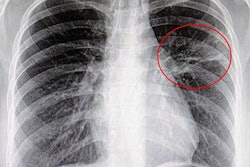
Lung ultrasound is a viable alternative to chest x-ray and CT for diagnosing pneumonia in children -- with a sensitivity of 94% and a specificity of 92% -- but it is dependent on operator experience, according to a study published online June 18 in Academic Emergency Medicine.
Although using ultrasound to diagnose pneumonia in children appears to be effective, sonographer experience must be taken into account, wrote a team led by Dr. Po-Yang Tsou of Driscoll Children's Hospital in Corpus Christi, TX.
"To our knowledge, this is the first article demonstrating significant differences in lung ultrasound's diagnostic accuracy for pneumonia between novice and advanced sonographers," Tsou and colleagues wrote. "[Our] findings suggest that the sonographer's experience level should be considered when using lung ultrasound to diagnose pneumonia in children."
Difficult diagnosis
Pneumonia is a leading cause of death in children around the world, the authors noted. In developed countries, the annual incidence rate is 33 per 10,000 children 0 to 5 years of age, with a mortality rate of less than one per 1,000 children. But in developing countries, the condition is more serious with an annual incidence rate of 2,900 per 10,000 children age 0 to 5 and a mortality rate of 26 per 1,000 children.
To make matters worse, diagnosis of pediatric pneumonia can be challenging, in part due to the variation in signs and symptoms. The illness has typically been identified with chest x-ray and clinical presentation. Chest CT is also used and has excellent diagnostic accuracy, but its drawbacks include radiation exposure, high cost, and the possible need for sedation of pediatric patients.
Past studies have suggested that lung ultrasound may be a viable alternative to these modalities for pediatric pneumonia, but it has been unclear whether operator dependence affects its accuracy.
"Studies measuring the diagnostic accuracy of lung ultrasound for childhood pneumonia generally report excellent sensitivity and specificity," the group wrote. "However, ultrasound's accuracy varies by user skill and training."
The researchers conducted a review study to assess the diagnostic accuracy of the modality and compared performance between novice and experienced sonographers. The team searched PubMed and EMBASE from their inception to February 2018 for studies that evaluated the utility of lung ultrasound in children with suspected pneumonia against the reference standard of either imaging results alone or a combination of clinical, laboratory, and imaging results. The group also assessed diagnostic accuracy between novice (seven days or fewer of training) and advanced sonographers.
The analysis included 25 studies with a total of 3,389 patients presenting with pneumonia symptoms. Of these 25, 18 were prospective cohort studies, five were retrospective cohort studies, one was a randomized controlled trial, and one case was a control study. Subjects were mostly infants, children, and adolescents. Of the studies included in the research, 16 used advanced sonographers, seven used novice sonographers, and two used sonographers of unknown training level in lung ultrasound.
Lung ultrasound showed an overall sensitivity of 94%, specificity of 92%, and an area under the curve (AUC) of 0.97. However, the group did find a significant difference in diagnostic accuracy for pneumonia between less experienced and more experienced sonographers, with novice sonographers showing less sensitivity than their advanced counterparts.
Tsou and colleagues also found that point-of-care lung ultrasound performed better than exams conducted in the radiology department.
| Comparison of sonographer experience and location for lung ultrasound | |||||
| Performance measure | Novice sonographers | Advanced sonographers | All sonographers | Point-of-care lung ultrasound | Radiology department lung ultrasound |
| Sensitivity | 80% | 96% | 94% | 94% | 91% |
| Specificity | 96% | 90% | 92% | 94% | 86% |
| AUC | 0.97 | 0.97 | 0.97 | 0.98 | 0.93 |
Not only does lung ultrasound show promise as a diagnostic tool for pediatric pneumonia, it also can be used to monitor disease progression without exposing children to radiation, costs less than more invasive tests, and may even decrease the length of stay in the emergency department.
Standardized curriculum
Novice sonographers included in this study had experience ranging from one hour to seven days of training. So what can be done to improve novice sonographers' ability to use lung ultrasound to diagnose pneumonia effectively? It comes down to instituting a standardized curriculum in the department, according to the research team.
"This study also importantly reveals the training of lung ultrasound impacts its diagnostic accuracy for pneumonia," the authors concluded. "[These] results indicate the need for a standardized curriculum, ideally consisting of a certain number of supervised scans and a post-test administered by ultrasound experts. ... Future studies are needed to standardize the curriculum for lung ultrasound training and determine the [number] of scans and duration of training required for a novice to achieve adequate proficiency in lung ultrasound."




















